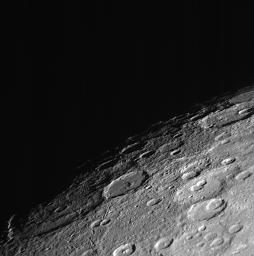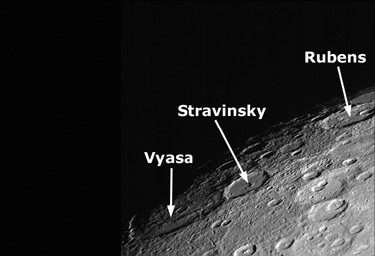
|
Mercury Through Time
- Click the image above for a larger view
- Full-Res JPEG (1018 x 1024) (110.9 kB)
- Full-Res TIFF (1018 x 1024) (1.0 MB)
Caption:

Click on image for larger annotated version
By examining the characteristics of craters and their relationships to each other, geologists are able to unravel the history of Mercury. This image shows a northern portion of Mercury's surface, looking at the terminator (the transition from the sunlit dayside to the dark night side of the planet). The crater in the lower left, Vyasa, has a rough floor, with other craters superimposed onto it, indicating that this crater is relatively old. In contrast, the neighboring crater, Stravinsky, has a much smoother floor and appears to overlap the rim of Vyasa, suggesting that this crater is relatively younger. These craters appear to be aptly named to support this relative age relationship; Vyasa is named for the ancient Indian poet from about 1500 BC, while Igor Stravinsky was a 20th century Russian-born composer. The nearby crater Rubens, named for the 17th century Flemish painter, may indeed represent an event intermediate in time between Vyasa and Stravinsky.
Date Acquired:
October 6, 2008
Image Mission Elapsed Time (MET):
131774338
Instrument:
Narrow Angle Camera (NAC) of the Mercury Dual Imaging System (MDIS)
Resolution:
580 meters/pixel (0.36 miles/pixel)
Scale:
Stravinsky crater is 190 kilometers in diameter (120 miles)
Spacecraft Altitude:
23,000 kilometers (14,000 miles)
Background Info:
These images are from MESSENGER, a NASA Discovery mission to conduct the first orbital study of the innermost planet, Mercury. For information regarding the use of images, see the MESSENGER image use policy .
Cataloging Keywords:
| Name | Value | Additional Values |
|---|---|---|
| Target | Mercury | |
| System | ||
| Target Type | Planet | |
| Mission | MESSENGER | |
| Instrument Host | MESSENGER | |
| Host Type | Orbiter | |
| Instrument | Mercury Dual Imaging System (MDIS) | |
| Detector | Narrow Angle Camera (NAC) | |
| Extra Keywords | Crater, Grayscale | |
| Acquisition Date | ||
| Release Date | 2008-10-10 | |
| Date in Caption | 2008-10-06 | |
| Image Credit | NASA/Johns Hopkins University Applied Physics Laboratory/Carnegie Institution of Washington | |
| Source | photojournal.jpl.nasa.gov/catalog/PIA11360 | |
| Identifier | PIA11360 | |
